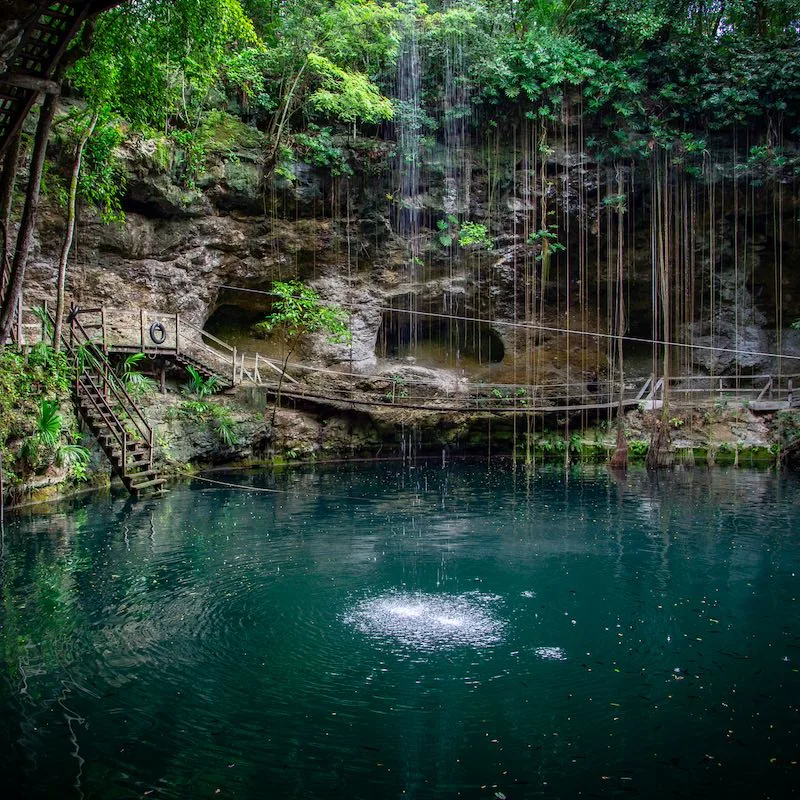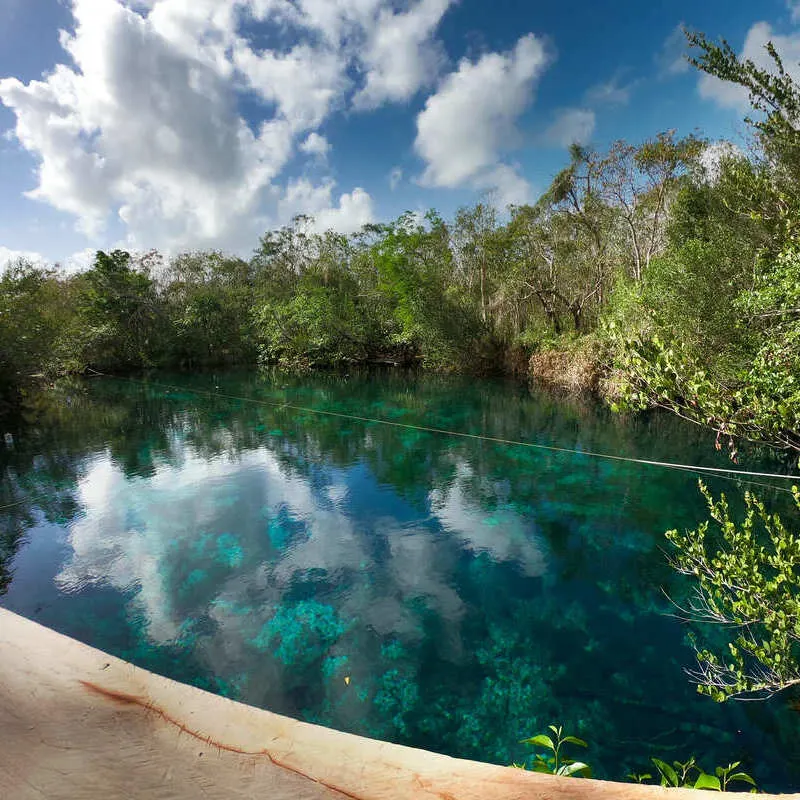[ad_1]
Last Updated
Now that the weather is getting warmer and sea temperatures are rising, sargassum seaweed is once again making landfall along Cancun’s coast, blighting some of the most popular swimming spots.
The algae are hardly harmful, but they have a reputation for smelling unpleasant and for blemishing the glistening white sands of Mexico’s Caribbean beaches when they build up along the shore.

While Cancun authorities have vowed to limit the spread of sargassum and keep the beaches clean this season, it can never be fully thwarted.
If you’re heading to Cancun this season, you should expect a higher incidence of seaweed on beaches, but this doesn’t mean your long-awaited tropical getaway is at risk of being ruined. You can always swim at a cenote instead:
What Is A Cenote?
Other than beaches, the Riviera Maya is famous for its mystical cenotes, natural pits with clear waters that were once used by the ancient Mayans for sacrificial offerings and now allow tourists an escape from the seaweed-filled beaches.

As they are inland sinkholes filled with fresh water coming from underground, they are not affected by seaweed.
There are numerous pristine cenotes within driving distance of Cancun, so if you’re renting a car during your Mexico trip or you’re thinking of booking a day tour to visit one of these natural wonders, here are 4 beautiful spots only an hour’s drive from the bustling Hotel Zone to consider:
Cenote Azul
Cenote Azul, aptly called the ‘Blue Cenote’, is an open-air swimming area a short 1h08 drive from downtown Cancun.
The nearest major settlement is Playa del Carmen, a popular day trip for sun-seekers looking to escape the hustle and bustle of the big city.
A bright-blue lagoon enclosed in a limestone basin bounded by a ring of trees, it is one of the most beautiful cenotes of its kind in the Riviera Maya. It also has a natural jumping point, making it a highly sought-after spot among cliff divers.
Top 5 Travel Insurance Plans For 2023 Starting At $10 Per Week
Easily Earn Points For Free Travel

You can either join them in line as you wait for your turn to backflip into the translucent waters below, or you may gently step into the pool for a bathing session or even snorkeling.
If you’re a nature enthusiast, you are likely to find various species of tiny fish inhabiting Cenote Azul.
It is worth noting this cenote is not free to explore. Entry costs 150 Mexican pesos, the equivalent of US$7.50 roughly, and tickets can be purchased at the main entrance. Life jackets are not a requirement, but they are generally recommended and may be rented for an additional 40 pesos.
Cenote Cristalino
Driving 1h15 south of Cancun along Federal Highway 307, you will see a few road signs pointing to the lovely detour that is Cenote Cristalino.
A semi-open cenote famous for its different shades of green and the cooling nature of the waters, it provides swimmers with a much-welcome relief from the soaring temperatures and excess humidity they are subject to vacationing in the Caribbean region over summer.

Much like the neighboring Azul, this cenote is equipped with jumping spots, and daring divers tend to get creative as they twirl and spin in the air on their way down. The standard entry fee is 200 Mexican pesos or just over ten bucks.
When traveling with family, especially your small ones, this is one of the safest cenotes to visit, as life jackets are included in the ticket, and the cenote itself is not as vast, being comparable to a large pool as opposed to a wide lagoon.
Cenote Siete Bocas
Siete Bocas is the cenote nearest to Cancun on this list, with a driving distance of just under an hour. A stone’s throw away from the resort town of Puerto Morelos; it is an underground haven that’s been in use by the Mayans since immemorial times.
Back then, the Mayans believed the underground caves acted as a gateway linking the living to the world of the dead, and these pre-Christian folkloric tales and centuries-old traditions have been passed down generations until the modern day.

Today, other than its historical importance for the Riviera Maya’s native inhabitants, the Cenote Siete Bocas is a natural swimming location foreign visitors love due to its tourist-friendly facilities and easy accessibility compared to other more remote, wild cenotes.
The cavern has up to 7 different openings that let the light in, and in order to swim in the ancient waters, you have two options: jumping from the nearby cliff or taking the ladder down to the pit. Either way, the cerulean blue hue will mesmerize you.
This one is more expensive, at 300 Mexican pesos, or about US$16, but the infrastructure is better, with a parking lot available to customers, as well as restrooms.
Cenote Jardin del Eden
Our last pick for this article, the ‘Garden of Eden’, is an expansive cenote ranked among the largest in the Yucatan Peninsula.
It has both an open-air section and underground limestone tunnels, and it’s one of a handful of cenotes where you can scuba dive alongside goby fish. The water itself is crystal-clear, though it often reflects the dense green foliage of the jungle that surrounds it.
For the thrill of active swimmers, this cenote is equipped with a main pool around 33 feet deep, and giant boulders and rock formations are arranged naturally around the pit, where they can sit atop and rest when tired from the constant moving.

The shallow ends are particularly favored by less adventurous swimmers, as well as seniors and young kids, as they can instead enjoy a free fish spa day or practice snorkeling.
Visitors must pay a 200-peso entry fee, though children aged 4 and below are entitled to pay half the price, or around five bucks.
Those coming with a car get free parking, but they must rent snorkeling gear and life jackets, if required, for a combo price of around US$5.

Visit A Cenote Instead Of The Beach This Summer
Visiting a cenote is a great way to escape the overwhelming humidity that settles in Southeastern Mexico during summer, and as they are not supplied by the ocean, they make for a great alternative to the seaweed-ridden beaches of Cancun.
When swimming in cenotes, however, tourists are encouraged to familiarize themselves with local safety protocols and wear life jackets where necessary due to their depth and any strong undercurrents that often go unnoticed by swimmers.
Read More:
Top 5 Travel Insurance Plans Starting At $10 Per Week
How To Easily Earn Points For Free Travel
↓ Join Our Community ↓
The Out Of Town Blogs Community FB group has all the latest reopening news, conversations, and Q&A’s happening daily!

SUBSCRIBE TO OUR LATEST POSTS
Enter your email address to subscribe to Out Of Town Blogs’s latest breaking travel news, straight to your inbox.
This article originally appeared on outoftownblogs.com
Opinions expressed here are the author’s alone, not those of any bank, credit card issuer, hotel, airline, or other entity. This content has not been reviewed, approved or otherwise endorsed by any of the entities included within the post.
[ad_2]
